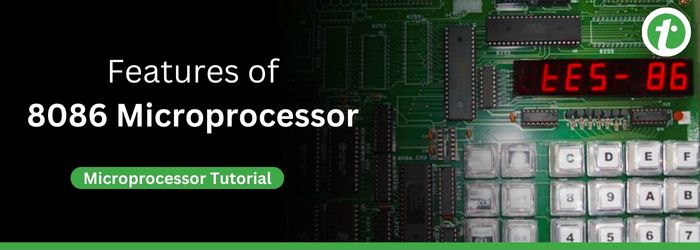
- Microprocessor - Home
- Microprocessor Overview
- Microprocessor Classification
- Microprocessor Evolution
- Microprocessor Components
- Microprocessor Characteristics
- Microprocessor Functions
- Microprocessor Pros & Cons
- Microprocessor Application
- Microcontrollers Types
- Microcontrollers Pros & Cons
- 8085 Microprocessor Architecture
- 8085 Microprocessor Pin Configuration
- Addressing Modes & Interrupts
- 8085 Microprocessor Instruction Sets
- 8085 Microprocessor Features
- Externally Initiated Operations
- 8086 Microprocessor
- 8086 Microprocessor Overview
- Functional Units
- Pin Configuration
- Instruction Sets
- 8086 Microprocessor Interrupts
- 8086 Microprocessor Addressing Modes
- 8086 Microprocessor Features
- Memory Segmentation
- Auxiliary Carry Flag
- Maximum and Minimum Mode Configurations
- Multiprocessor Configuration
- Configuration Overview
- 8087 Numeric Data Processor
- I/O Interfacing
- I/O Interfacing Overview
- 8279 Programmable Keyboard
- 8257 DMA Controller
- Serial vs Parallel Communication
- Serial Communications Interface
- Parallel Communication Interface
- 8051 Microcontrollers
- Microcontrollers Overview
- 8051 Microcontrollers Architecture
- 8051 Pin Description
- 8051 Input Output Ports
- 8051 Microcontrollers Interrupts
- Instruction Sets
- Logical Instructions in AVR
- Conditional Branch Instructions AVR
- Peripheral Devices
- Programmable Peripheral Interface
- Intel 8255A Pin Description
- Programmable Interval Timer
- 8253/54 Operational Modes
- Interfacing Devices
- Applications and Furture Trends
- Microcontrollers - Application
- Microprocessor Useful Resources
- Microprocessor - Quick Guide
- Microprocessor - Useful Resources
- Microprocessor - Discussion
Features of 8086 Microprocessor
The 8086 Microprocessor is a 16-bit microprocessor developed by Intel Corporation in the year of 1978, and it was marked as a milestone in the history of computing technology. With being the first x86 architecture microprocessor, it paved the path for the development of modern microprocessors. As it is a 16-bit microprocessor, it can process 16-bits of digital data in a single cycle.

The 8086-microprocessor was used as the core component in the personal computers and embedded systems during its age. In this chapter, we will learn about some of the important features of the 8086-microprocessor in detail.
Features of 8086-Microprocessor
Some of the key features of the 8086-microprocessor are elaborated in detail below −
16-Bit Architecture
The 8086 microprocessor has a 16-bit architecture which means it can handle or process 16-bits of digital data simultaneously. Being an advanced version of the 8085-microprocessor, it provides a better performance and computing power.
16-Bit Data Bus
The 8086-microprocessor consists of the 16-bit data bus, thus it can transfer data between the processor and memory and ports either 16-bits or 8-bits at a time.
20-Bit Address Bus
It is another key feature of the 8086-microprocessor that is it comprises a 20-bit address bus. Therefore, it allows for directly accessing up to 220 (1 MB) memory locations.
Each of these 1 MB memory locations is a byte, hence a 16-bit word is stored in two consecutive memory locations.
16-Bit I/O Addresses
The 8086-micrprocessor comes with 16-bit I/O addresses and provides support for accessing up to 216 (65,536) input-output ports. This feature makes the 8086-microprocessor versatile for interfacing with external peripherals.
Registers
The 8086-microprocessor comprises fourteen 16-bit registers for various purposes such as data storage, memory addressing, and execution of instructions. These registers are categorized as follows −
- General Purpose Registers − These registers include AX, BX, CX, and DX.
- Segment Registers − They are CS, DS, SS, and ES.
- Special Purpose Registers − These are also called Index and Pointer Registers, and they are SP, BP, SI, DI, and IP
- Flag Registers − These are also known as status registers, and they include conditional flags and control flags.
Multiplexed Address and Data Bus
The 8086-microprocessor consists of the multiplexed address and data bus (AD0-AD15). This feature reduces the number of pins required in the microprocessor. However, it also introduces a drawback which is it slows down the data transfer.
Clock Speed
The 8086-microprocessor requires a single-phase clock with a 33% duty cycle for providing optimized internal timing. Different models of the 8086-microprocessor operate at different clock frequencies, as follows −
- 8086 operates at 5 MHz.
- 8086-2 operates at 8 MHz.
- 8086-1 operates at 10 MHz.
Operating Modes
The 8086-microprocessor has two modes of operation namely, minimum mode and maximum mode. In the minimum mode of 8086-microprocessor, only one processor is used and the MN/MX pin is connected to logic 1. The maximum mode is used in multiprocessor systems and it is achieved by connecting the MN/MX pin to logic 0.
Instruction Prefetching
This is another unique feature of the 8086-microprocessor. This feature allows the microprocessor to prefetch up to 6 instruction bytes from the memory and queues them to minimize the waiting time for fetching instructions and improve the execution speed of the instructions.
Multiprogramming
The 8086-microprocessor also supports the feature of multiprogramming. This feature enables the microprocessor to store two or more processes in memory at the same time and execute in a time-multiplexed fashion.
Powerful Instruction Set
The 8086-microprocessor has a powerful instruction set with the following addressing modes −
- Register addressing
- Immediate addressing
- Direct addressing
- Indirect addressing through an index or a base register
- Indirect addressing through the sum of a base or index register
- Relative addressing
- Implied addressing
Arithmetic and Logical Operations
The 8086-microprocessor is capable in performing arithmetic and logical operations such as addition, subtraction, multiplication, division, AND, OR, NOT, and XOR on bits, bytes, words, and blocks.
Packaging
The 8086-microprocessor comes in a 40-pin ceramic or plastic Dual Inline Package (DIP).
Power Supply
The 8086-microprocessor requires a power supply of +5V to operate.
Memory Addressing
In the 8086-microprocessor, the memory is byte-addressable which means that each byte in the memory uses a unique memory address. It improves efficiency of data storage and transfer.
Conclusion
In this chapter, we provided an overview of all the key features of the 8086 microprocessor. Understanding these features of 8086-microprocessor can be very helpful for building a strong foundation computing and microprocessor technologies.
